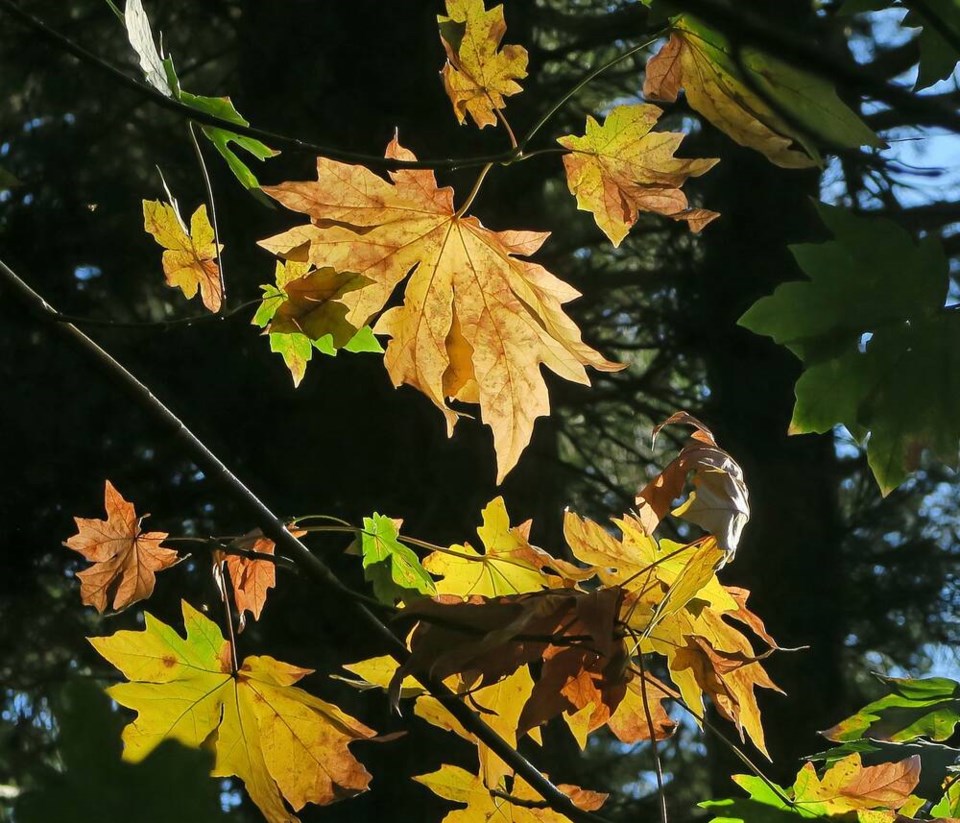During a recent stroll in a local park, we watched kids competing to find the biggest leaf.
“Mine’s bigger than yours,” one squealed, waving a maple leaf around like it was a flag.
“No, this one’s bigger,” the other insisted, holding her leaf as if it were a precious golden platter.
The region’s maples are beginning to change colour and drop their leaves en masse.
Among them, the leaves of the bigleaf maple usually stand out in size. This species, native to North America’s west coast and usually found growing near streams, in ravines or on other damp ground, has the largest leaves of any maple species, typically up to 35 cm wide and 60 cm long. However, the biggest leaf on record — found in a backyard near John Dean Park in 2014 — was 60.9 cm wide and 72 cm long.
Even in pointy-headed circles, the species is known for big leaves. Its scientific name, Acer macrophyllum, means “maple bigleaf.”
But this year, in local parks where bigleaf maples are common, many of the leaves just didn’t seem to measure up to their reputation. Instead of being the size of platters and dinner trays, many seemed merely the size of dinner plates or even — gasp! — salad plates. That’s not much bigger than a bog-standard red or vine maple leaf.
The maples also seemed to be dropping leaves in August and even July.
According to a paper published Sept. 16 in the journal Forest Ecology and Management, those impressions may not have been mere imaginings by an overheated brain after all. Over the border to the south, researchers have now linked a decade-long die-off of bigleaf maples in Washington to recent hotter, drier summers across the Pacific Northwest. Their study shows those conditions weaken the tree’s immune system, leaving it vulnerable to other stressors and diseases.
“These trees can tolerate a lot, but once you start throwing in other factors, particularly severe summer drought as in recent years, it stresses the trees and can lead to their death,” says Patrick Tobin, one of the study’s authors.
The study focused on Washington, but weather recognizes no boundaries. The entire wet coast just hasn’t been wet enough at all of the right times of year in many recent years. This summer’s long drought and recurring heat waves — 569 heat-related deaths in B.C. and a billion shellfish boiled and roasted alive along our shorelines — were extremes among the past decade’s hot, dry summers.
Bigleaf maples are paying the price.
The University of Washington study revealed that 22 per cent of the maples sampled from 59 sites across western Washington showed symptoms of decline, and in hot, dry summers, bigleaf maples simply grew less. They produced less wood — had smaller growth rings — in each of those years.
The trees also produced significantly smaller leaves.
Smaller leaves are a key sign of distress in deciduous trees. Stressed trees direct more energy into just trying to survive and defend themselves from diseases and other threats. As a result, they put less energy into producing leaves — therefore, smaller leaves.
But smaller leaves mean less surface area for photosynthesis, or smaller solar panels. Smaller solar panels mean the tree produces less food for itself. Less food means less wood and less energy to direct to basic survival and defence from pests if stressful conditions continue or return. And that means — eek! — more stress.
Another common symptom of maple dieback is premature leaf fall. The leaves shrivel up and die during the summer, as we saw in the region’s parks in July and August.
When a tree loses too many leaves too early in the season, the plants start drawing on stored energy reserves sooner. If this repeats year after year, the decline becomes a slow, lingering case of starvation — although we can usually count on insects or disease overcoming the tree’s weakened defences and administering the coup de grace long before the tree completely withers away on its own.
The researchers also found that bigleaf maples are more likely to decline near roads and other development, particularly in urban areas, which tend to be hotter than forest environments.
If we continue to have extreme summers like we had this year, bigleaf maples will become decidedly less-big-leafed maples.
And finding platter-sized leaves will become a rare, treasured privilege.



